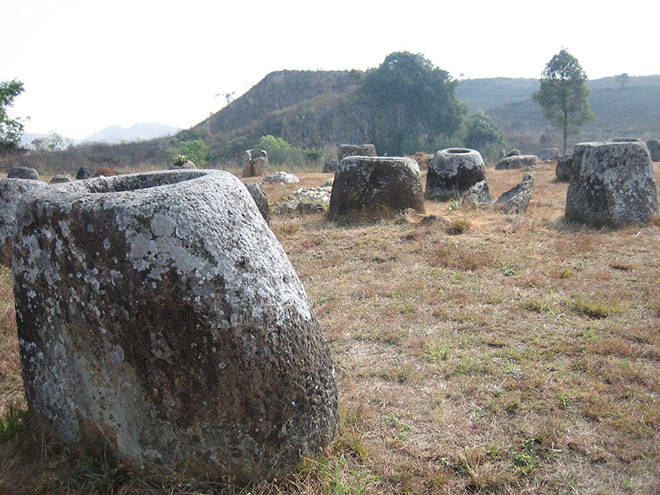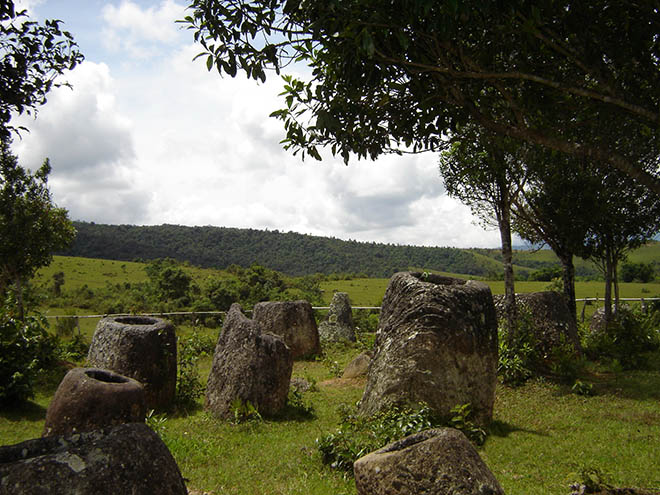Set Foot On One Of The Most Myths In The World: The Plain Of Jars
Stretching thousands of miles along the hillside of Xieng Khouang plateau, the Plain of Jars is more than just a famous cultural and historical area of Laos. It is truly one of the most persistent myth of modern science. The site covers an area of up to 25 hectares with the presence of approximately 1969 jars of all shapes and sizes distributed in 52 major locations.
At some points, the Plain of Jars might have been the collective burial of ancient human beings. It could also be a creation of the mysterious aliens in the past. The story of the Plain of Jars is still out of the question. In the eyes of every tourist to Laos, the unsought origin looks even more attractive


The Irresistible Charm Of The Plain Of Jars
The Plain of Jars sets on the most significant highland of Indochina peninsula, Xieng Khouang or Horizontal City in Laos language. At the height of around 1,300m above sea level, Xieng Khouang features a notable attraction in the modest country of Laos. It's the Plain of Jars. Surrounded by a long-gone history that can never be confirmed, the Plain of Jars is truly a destination for unsought mystery seekers to boost the adrenaline level with legends and tales.
When I first encountered the Plain of Jars from afar, I envisioned a chessboard where each giant stone resembled a chess piece. It brings to my mind the picture of the legendary Stonehedge of the United Kingdom. But the Plain of Jars is even more massive in terms of size and ain't less mysterious in terms of origin.
Only when I got closer did I notice that each jar possesses a distinctive look. Some are standing straightforward; some are buried halfway. There are even mysterious imprints on some huge jars while the smallest ones don't have. It looks both like a nasty mess and an unknown arrangement of whoever created the Plain of Jars.
A Myriad Of Mysteries Encircling The Plain Of Jars
Despite the best attempts of the archaeologists, the origin and purpose of the Plain of Jars still remain a mystery.
The jars have various height and diameter, ranging between 1m and 3m. All of them were hewn from rock, giving an impression of the iconic Stonehenge of the United Kingdom. Their cylindrical shape is usually wider at the bottom with bas-reliefs carved on the exterior. However, the decoration was only found on jars situated at Site 1.
The rock painting depicted some kinds of animals like frogs, monkeys, and tigers. On enormous jars were carved with images of human knee bending and arms reaching towards the sky. Those pictures are similar to Chinese paintings traced back to 500 BC–200 AD, so there is guessing that the Plain of Jars was formed at that time too. Still, nothing can be sure about the mysterious culture that painstakingly carved in the stone jars. And the somber and eerie vibe is still embracing the Plain of Jars.
The jars used to be thought to be containers of food and rainwater, but after the discovery of human bones and teeth around the area in the 1930s, this theory was disproved. Instead, archeologists start to think of the jars as a burial for dead people. The Thai and Cambodian are proved to follow familiar funerary practices. However, as a result of the bombardment during wars, evidence gathered was not enough to make a firm statement.
Surrounded by a long-gone history that can never be confirmed, the Plain of Jars is truly a destination for unsought mystery seekers to boost the adrenaline level with legends and tales.

Detailed Instructions For An Ideal Expedition To The Plain Of Jars
The Plain Of Jars is a massive area consisting of thousands of stone jars scattering around the Xiangkhoang Plateau. The plateau is at the northern end of the Annamese Cordillera, a significant mountain range of Indochina.
Due to the magnificence of the landscape, the local authority has divided it into 90 jar sites. However, you are not allowed to wander around all 90 stops because of safety reasons. Tourists can be free to visit Site 1, Site 2, Site 3, Site 16, Site 23, Site 25, and Site 52.
The most popular choice is Site 1, which is the closest to Phonsavan town, super convenient for commuting. From Site 1, you can comfortably get to Site two by motorbike or tuk-tuk and then reach Site 3 via hiking. Site 52 is the largest area, beholding 392 jars; however, it is very remote and only accessible on foot.Â
To join in a tour around the Plain Of Jars, you have to catch a flight to Vientiane or Luang Prabang, two transport hubs in Laos. From Vientiane airport, you can get on a plane operated by domestic airways such as Laos Airlines to arrive at Xiangkhoang airport. It's only 3 km from Phonsavan town, where Site 1 of the Plain of Jars is. Flights from Vientiane to Xiangkhoang takes merely 30 minutes, however, costs up to $100.
You can also take a daily bus from either of Vang Vieng, Luang Prabang, Vientiane to Phonsavan. However, it is an 8 to 11-hour transfer so you can be extremely exhausted, let alone carsick. The most cost-saving way maybe hire a private van or book a trip with a liable tour operator so that you can take control of your schedule.
To get into the field, you also need to pay an entrance fee of about $1.5, which is more than affordable.

